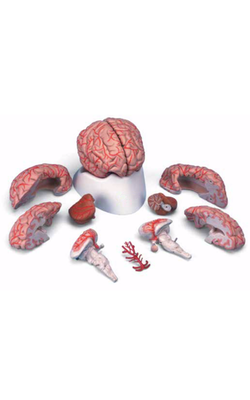Main Model

Cranial Nerves : VII Facial nerve

Facial Nerve (CN VII)
Functions: Sensory - special sensory (taste) and somatic (general) sensory. Motor - somatic (branchial) motor and visceral (parasympathetic) motor. It also carries proprioceptive fibers from the muscles it innervates.
Nuclei: The motor nucleus of the facial nerve is a branchiomotor nucleus in the ventrolateral part of the pons. The cell bodies of the primary sensory neurons are in the geniculate ganglion. The central processes of those concerned with taste end in the nuclei of the solitary tract in the medulla. The processes of those concerned with general sensations (pain, touch, and thermal) from around the external ear end in the spinal nucleus of the trigeminal nerve.
The facial nerve (CN VII) emerges from the junction of the pons and medulla as two divisions: the primary root and the intermediate nerve. The larger primary root (facial nerve proper) innervates the muscles of facial expression, and the smaller intermediate nerve (Latin nervus intermedius) carries taste, parasympathetic, and somatic sensory fibers. During its course, CN VII traverses the posterior cranial fossa, internal acoustic meatus, facial canal, stylomastoid foramen of the temporal bone, and parotid gland. After traversing the internal acoustic meatus, the nerve proceeds a short distance anteriorly within the temporal bone and then turns abruptly posteriorly to course along the medial wall of the tympanic cavity. The sharp bend, the geniculum of the facial nerve (Latin genu, knee) is the site of the geniculate ganglion, the sensory ganglion of CN VII. While traversing the temporal bone within the facial canal, CN VII gives rise to the:
• Greater petrosal nerve.
• Nerve to the stapedius.
• Chorda tympani nerve.
Then, after running the longest intra-osseous course of any cranial nerve, CN VII emerges from the cranium via the stylomastoid foramen; gives off the posterior auricular branch; enters the parotid gland; and forms the parotid plexus, which gives rise to the following five terminal motor branches: temporal, zygomatic, buccal, marginal mandibular, and cervical.
Somatic (Branchial) Motor
As the nerve of the 2nd pharyngeal arch, the facial nerve supplies striated muscles derived from its mesoderm, mainly the muscles of facial expression and auricular muscles. It also supplies the posterior bellies of the digastric, stylohyoid, and stapedius muscles.
Visceral (Parasympathetic) Motor
CN VII provides presynaptic parasympathetic fibers to the pterygopalatine ganglion for innervation of the lacrimal glands and to the submandibular ganglion for innervation of the sublingual and submandibular salivary glands. The pterygopalatine ganglion is associated with the maxillary nerve (CN V2), which distributes its postsynaptic fibers, whereas the submandibular ganglion is associated with the mandibular nerve (CN V3). Parasympathetic fibers synapse in these ganglia, whereas sympathetic and other fibers pass through them.
Somatic (General) Sensory
Some fibers from the geniculate ganglion supply a small area of the skin of the concha of the auricle, close to external acoustic meatus.
Special Sensory (Taste)
Fibers carried by the chorda tympani join the lingual nerve of CN V3 to convey taste sensation from the anterior two thirds of the tongue and soft palate.